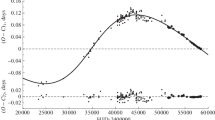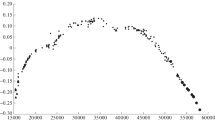Abstract—
Variations of the orbital period of the eclipsing binaries TT Del, EU Hya, and SV Tau have been studied. It has been shown that they can be represented by cyclic fluctuations without a secular change. Cyclic variations of the EU Hya and SV Tau periods can be explained by the light-time effect due to the presence of the third body in the system. The long period of EU Hya is 22.7 yr, 107.5 yr of SV Tau. The minimum masses of the extra bodies in these systems are 0.26\({{M}_{ \odot }}\) and 0.38\({{M}_{ \odot }}\), respectively. In TT Del, a superposition of two cyclic variations of the orbital period with the periods of 21.1 and 54.5 yr is present. Variations of the TT Del period can be explained both by the light-time effect and by magnetic cycles.








Similar content being viewed by others
REFERENCES
Kh. F. Khaliullin, Sov. Astron. 18, 229 (1974).
A. I. Khaliullina, Astron. Rep. 59, 717 (2015).
A. I. Khaliullina, Astron. Rep. 60, 807 (2016).
A. I. Khaliullina, Astron. Rep. 61, 612 (2017).
A. I. Khaliullina, Astron. Rep. 61, 859 (2017).
B.R.N.O. Project—Eclipsing Binaries Database. http://var2.astro.cz/EN/brno/index.php.
L. Plaut, Astron. Nachr. 244, 289 (1932).
M. A. Svechnikov and E. F. Kuznetsova, Catalog of Approximate Photometric and Absolute Elements of Eclipsing Variable Stars (Ural. Univ., Sverdlovsk, 1990) [in Russian].
E. M. Halbedel, Inform. Bull. Var. Stars 2549, 1 (1984).
S. Qian, Astron. J. 119, 3064 (2000).
A. I. Khaliullina, Astron. Rep. 63, 182 (2019).
D. Ya. Martynov, Variable Stars, Vol. 3: Methods for Variable Stars Studying (Gostekhizdat, Moscow, 1947) [in Russian].
A. I. Khaliullina and Kh. F. Khaliullin, Sov. Astron. 28, 228 (1984).
J. H. Applegate, Astrophys. J. 385, 621 (1992).
A. F. Lanza, M. Rodono, and R. Rosner, Mon. Not. R. Astron. Soc. 296, 893 (1998).
A. F. Lanza and M. Rodono, Astron. Astrophys. 349, 887 (1999).
C. Hoffmeister, Astron. Nachr. 242, 129 (1931).
K. Kordylewski, Roczn. Astron. Obserw. Krakow., No. 18 (1947).
K. Kordylewski, Roczn. Astron. Obserw. Krakow., No. 24 (1953).
H. Busch and K. Haussler, Inform. Bull. Variable Stars 639, 1 (1972).
A. G. Kulkarni, C. Raghavender Rao, and R. Swaminathan, Contrib. Nizamiah Japal-Rangapur Observ., No. 6 (1978).
A. G. Kulkarni, Contrib. Nizamiah and Japal-Rangapur Observ., No. 7 (1978).
A. G. Kulkarni, Doctoral Thesis (Osmania Univ., Khaidarabad, India, 1979).
P. V. Rao, M. B. K. Sarma, and K. D. Abhyankar, Publ. Astron. Soc. Pacif. 108, 967 (1996).
S.-H. Gu, Q.-Y. Liu, Y.-L. Yang, and B. Wang, Astrophys. Space Sci. 203, 189 (1993).
Y.-G. Yang, Q. Li, H.-L. Li, and H.-F. Dai, Res. Astron. Astrophys. 16, 35 (2016).
S.-H. Gu, Inform. Bull. Variable Stars 4078, 1 (1994).
S.-B. Qian and S. Boonrucksar, Publ. Astron. Soc. Jpn. 55, 499 (2003).
E. Pickering, Astron. Nachr. 179, 39 (1908).
S. Enebo, Astron. Nachr. 184, 255 (1910).
E. Zinner, Astron. Nachr. 187, 177 (1911).
H. Shapley, Astrophys. J. 38, 158 (1913).
K. Lassovszky, Abhandl. Sternw. Budapest-Svabbadsaghegy, No. 6 (1938).
L. N. Koshkina, Perem. Zvezdy 13, 412 (1961).
M. I. Lavrov and N. V. Lavrova, Tr. Kazan. AO 49, 18 (1985).
C. R. Chambliss and R. L. Walker, Astron. J. 102, 1409 (1991).
J. Mergentaler, Acta Astron., Ser. C 2, 65 (1934).
J. M. Kreiner, Acta Astron. 21, 365 (1971).
A. E. Prikhod’ko, Astron. Tsirk. 191 (1958).
C. R. Chambliss, Inform. Bull. Var. Stars 2164, 1 (1982).
Author information
Authors and Affiliations
Corresponding author
Rights and permissions
About this article
Cite this article
Khaliullina, A.I. Light-Time Effect in the Orbital Period Variations of the Eclipsing Binaries TT Del, EU Hya, and SV Tau. Astron. Rep. 66, 535–544 (2022). https://doi.org/10.1134/S1063772922080078
Received:
Revised:
Accepted:
Published:
Issue Date:
DOI: https://doi.org/10.1134/S1063772922080078




